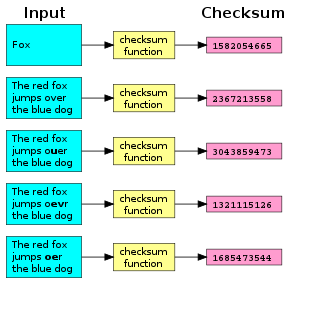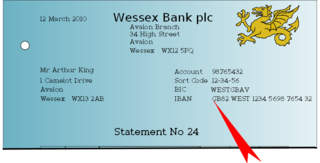
A checksum is a small-sized block of data derived from another block of digital data for the purpose of detecting errors that may have been introduced during its transmission or storage. By themselves, checksums are often used to verify data integrity but are not relied upon to verify data authenticity.

The International Standard Book Number (ISBN) is a numeric commercial book identifier that is intended to be unique. Publishers purchase or receive ISBNs from an affiliate of the International ISBN Agency.

The International Bank Account Number (IBAN) is an internationally agreed upon system of identifying bank accounts across national borders to facilitate the communication and processing of cross border transactions with a reduced risk of transcription errors. An IBAN uniquely identifies the account of a customer at a financial institution. It was originally adopted by the European Committee for Banking Standards (ECBS) and since 1997 as the international standard ISO 13616 under the International Organization for Standardization (ISO). The current version is ISO 13616:2020, which indicates the Society for Worldwide Interbank Financial Telecommunication (SWIFT) as the formal registrar. Initially developed to facilitate payments within the European Union, it has been implemented by most European countries and numerous countries in other parts of the world, mainly in the Middle East and the Caribbean. By July 2023, 86 countries were using the IBAN numbering system.

A prime number is a natural number greater than 1 that is not a product of two smaller natural numbers. A natural number greater than 1 that is not prime is called a composite number. For example, 5 is prime because the only ways of writing it as a product, 1 × 5 or 5 × 1, involve 5 itself. However, 4 is composite because it is a product (2 × 2) in which both numbers are smaller than 4. Primes are central in number theory because of the fundamental theorem of arithmetic: every natural number greater than 1 is either a prime itself or can be factorized as a product of primes that is unique up to their order.
An International Securities Identification Number (ISIN) is a code that uniquely identifies a security globally for the purposes of facilitating clearing, reporting and settlement of trades. Its structure is defined in ISO 6166. The ISIN code is a 12-character alphanumeric code that serves for uniform identification of a security through normalization of the assigned National Number, where one exists, at trading and settlement.
In recreational mathematics, a Keith number or repfigit number is a natural number in a given number base with digits such that when a sequence is created such that the first terms are the digits of and each subsequent term is the sum of the previous terms, is part of the sequence. Keith numbers were introduced by Mike Keith in 1987. They are computationally very challenging to find, with only about 100 known.
A check digit is a form of redundancy check used for error detection on identification numbers, such as bank account numbers, which are used in an application where they will at least sometimes be input manually. It is analogous to a binary parity bit used to check for errors in computer-generated data. It consists of one or more digits computed by an algorithm from the other digits in the sequence input.
A CUSIP is a nine-character numeric or alphanumeric code that uniquely identifies a North American financial security for the purposes of facilitating clearing and settlement of trades. All CUSIP identifiers are fungible, which means that a unique CUSIP identifier for each individual security stays the same, regardless of the exchange where the shares were purchased or venue on which the shares were traded. CUSIP was adopted as an American national standard by the Accredited Standards Committee X9 and is designated ANSI X9.6. CUSIP was re-approved as an ANSI standard in December 2020. The acronym derives from Committee on Uniform Security Identification Procedures.
A national identification number, national identity number, or national insurance number or JMBG/EMBG is used by the governments of many countries as a means of tracking their citizens, permanent residents, and temporary residents for the purposes of work, taxation, government benefits, health care, and other governmentally-related functions.
In mathematics, the digit sum of a natural number in a given number base is the sum of all its digits. For example, the digit sum of the decimal number would be

The European Community number is a unique seven-digit identifier that was assigned to substances for regulatory purposes within the European Union by the European Commission. The EC Inventory comprises three individual inventories, EINECS, ELINCS and the NLP list.
In number theory, a narcissistic number in a given number base is a number that is the sum of its own digits each raised to the power of the number of digits.
The Verhoeff algorithm is a checksum for error detection first published by Dutch mathematician Jacobus Verhoeff in 1969. It was the first decimal check digit algorithm which detects all single-digit errors, and all transposition errors involving two adjacent digits, which was at the time thought impossible with such a code.
PESEL is the national identification number used in Poland since 1979. The number is 11 digits long, identifies exactly one person, and cannot be changed once assigned, except in specific situations.
A mobile equipment identifier (MEID) is a globally unique number identifying a physical piece of CDMA2000 mobile station equipment. The number format is defined by the 3GPP2 report S.R0048 but in practical terms, it can be seen as an IMEI but with hexadecimal digits.
The Luhn mod N algorithm is an extension to the Luhn algorithm that allows it to work with sequences of values in any even-numbered base. This can be useful when a check digit is required to validate an identification string composed of letters, a combination of letters and digits or any arbitrary set of N characters where N is divisible by 2.
The digital root of a natural number in a given radix is the value obtained by an iterative process of summing digits, on each iteration using the result from the previous iteration to compute a digit sum. The process continues until a single-digit number is reached. For example, in base 10, the digital root of the number 12345 is 6 because the sum of the digits in the number is 1 + 2 + 3 + 4 + 5 = 15, then the addition process is repeated again for the resulting number 15, so that the sum of 1 + 5 equals 6, which is the digital root of that number. In base 10, this is equivalent to taking the remainder upon division by 9, which allows it to be used as a divisibility rule.
The cyclic redundancy check (CRC) is based on division in the ring of polynomials over the finite field GF(2), that is, the set of polynomials where each coefficient is either zero or one, and arithmetic operations wrap around.

The IMO number of the International Maritime Organization is a generic term covering two distinct meanings. The IMO ship identification number is a unique ship identifier; the IMO company and registered owner identification number is used to identify uniquely each company and/or registered owner managing ships of at least 100 gross tons (gt). The schemes are managed in parallel, but IMO company/owner numbers may also be obtained by managers of vessels not having IMO ship numbers. IMO numbers were introduced to improve maritime safety and reduce fraud and pollution, under the International Convention for the Safety of Life at Sea (SOLAS).

The Resident Identity Card is an official identity document for personal identification in the People's Republic of China. According to the second chapter, tenth clause of the Resident Identity Card Law, residents are required to apply for resident identity cards from the local Public Security Bureau, sub-bureaus or local executive police stations.












